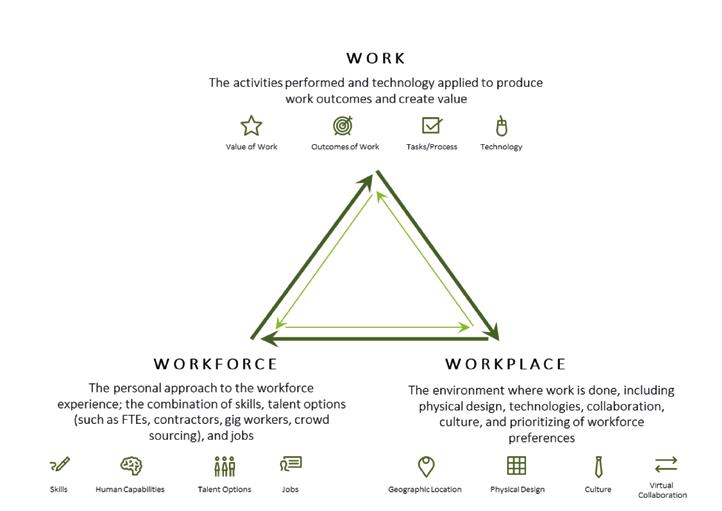VIRTUAL ASSIGNMENTS
Virtual Assignments: Future-Proofing Your Mobility Programmes The Genesis Of A New Type Of Assignment
Technology has profoundly changed our personal and professional lives over time. We now routinely work in virtual teams with colleagues and clients who are in different physical locations. On this basis, many HR professionals had predicted that some international assignments would eventually be replaced by employees working remotely in cross-border roles, i.e. without physically moving, an arrangement commonly called “virtual assignment”. Whilst the concept is not entirely new, very few organisations have integrated virtual assignments in their Global Mobility frameworks, due to a variety of challenges that would need to be addressed. The recent COVID-19 pandemic turned out to be a catalyst for change: most organisations had no choice but to repatriate their international assignees, put on hold all new assignments, and ask both international and domestic employees to work from home. Suddenly, remote employment had become a reality. Despite the disastrous impact on people and businesses, the crisis provided an important “reality check” on how much work can be done remotely. It is not surprising, therefore, that the topic of virtual assignments gained popularity amongst Mobility professionals. But is it feasible to take an arrangement that was borne out of a crisis, and recognise it as an official assignment type? The answer is “maybe”, provided the implications and complexities are understood and addressed. Let’s look at some fundamental considerations.
Why Virtual Assignments?
The pandemic, together with the associated lockdowns and travel restrictions, definitely played a key role in pushing Virtual Assignments higher on the agenda of Mobility professionals. But other factors provided the right context too. The digitalisation of many aspects of work made it possible for some roles to be performed remotely. At the same time, workforce demographics are changing, with a growing representation of a younger workforce that grew up in the digital age, and generally more tolerant of flexible working practices.
Virtual assignments also provide a potential alternative in situations where employees may be reluctant to move physically, due to personal or family considerations, which can be real barriers to mobility. This means that virtual assignments may allow organisations to secure the best talent, irrespective of their location and propensity to relocate. Some employers may one day also use virtual assignments to optimise human capital costs, by reducing the need for expensive expatriate packages and leveraging salary differentials across locations. It appears, therefore, that the timing may be right: virtual assignments have the potential to meet the needs and expectations of both employers and employees, albeit in different ways. Technology tools that enable us to work remotely have already become mainstream in many organisations, and the pandemic forced us to learn quickly how to run a business with a geographically distributed workforce. It is unlikely that virtual assignments will fizzle out once the pandemic blows over. More likely, they will be increasingly recognised as a legitimate assignment type and formally integrated in mobility programmes.
Key Challenges
Nevertheless, virtual assignments are fraught with challenges, which need to be understood and addressed in order to succeed. Here’s a few: Feasibility, Eligibility And Cost For a start, it is important to define the eligibility criteria for virtual assignments, by identifying which jobs could be realistically performed remotely. In addition to the practical requirements of the role, it may be wise to consider other factors such as time zones, geographical scope of the role, the presence of a local subsidiary, access to IT support, and more. It would be unwise to assume that a virtual assignment will always cost less than a traditional assignment, as this is often not the case. Therefore, it would be advisable to run some simulations to estimate the financial impact.
Regulatory And Compliance Considerations One of the key considerations for virtual assignments is to determine which entity is the “employer of record” and who will be responsible for compliance obligations such as tax withholdings, payroll reporting, employer’s social contributions, and so on. If the organisation has a local subsidiary, this could be used to host and support the virtual assignee, but if the company has no legal presence in the country, the situation becomes slightly more complicated, since some countries allow such “employment without establishment”, whereas others don’t. It is important to remember that the prevailing labour law will be that of the country where the virtual assignee is physically located. Hence the HR team managing these virtual assignees needs to ensure compliance in all applicable jurisdictions. This is an important point to remember, especially in the event of disputes, disciplinary procedures, separations, etc. It is also worth bearing in mind that in some countries there may be collective agreements applicable to specific industry sectors. Local legislation will also dictate any minimum statutory benefits that need to be provided, such as medical, life, accident and disability. In locations where the headcount is low, these insurance plans may be expensive, due to lack of critical mass. Lastly, there is the well-known issue of Permanent Establishment risk, which could be created when an employee is performing work in one country on behalf of an overseas entity. The details of what constitutes a Permanent Establishment are generally to be found in tax treaties, and there is no universal definition. Typically, such situations could give rise to Corporate Tax and/or VAT liabilities, which need to be taken into account. Cultural Readiness Any organisation considering the introduction of any form of “remote employment” should carefully consider whether the organisation is culturally ready for it. The “cultural readiness” could be specific to a geographic region, or it could depend on the organisation, its leadership and the demographic profile of the workforce. In some cultures, both
15










